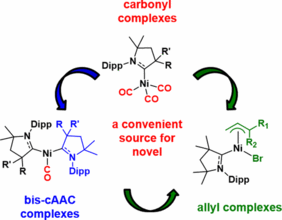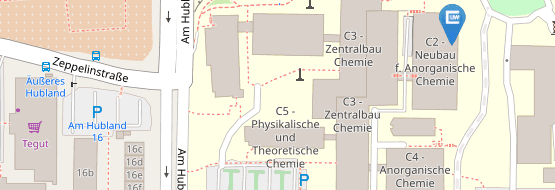Just Published in Organometallics
03/27/2017Synthesis and Reactivity of Cyclic (Alkyl)(Amino)Carbene Stabilized Nickel Carbonyl Complexes
Authors: Ursula S. D. Paul and Udo Radius*
Abstract: Cyclic (alkyl)(amino)carbenes cAACcy (1b) and cAACmenthyl (1c) react with [Ni(CO)4] to give the 18 VE complexes [Ni(CO)3(cAACcy)] (2b) and [Ni(CO)3(cAACmenthyl)] (2c). With these in hand, the donor-strength and the steric profile of the respective cAAC ligands were evaluated. CAACcy and cAACmenthyl possess similar overall-donating properties (Tolman electronic parameter (TEP) = 2046 (1b) and 2042 (1c)) as common NHCs, though they are also known to be better π-acceptors. 3,3-Diamino-2-aryloxyacrylimidamide 3b, arising from the reaction of cAACcy (1b) with released CO molecules, was obtained as side-product of CO substitution reactions at nickel carbonyls. In contrast to cAACmenthyl (%Vbur = 42), the sterically less encumbered cAACcy (%Vbur = 38) undergoes a subsequent CO substitution at [Ni(CO)3(cAACCy)] (2b) to afford the 16 VE complex [Ni(CO)(cAACcy)2] (4b). Treatment of both [Ni(CO)3(cAACmethyl)] (2a) and [Ni(CO)(cAACmethyl)2] (4a) with allyl bromides led to the formation of cAAC-stabilized allyl nickel complexes [NiBr(η3-H2C═CH–CH2)(cAACmethyl)] (5a) and [NiBr(η3-H2C═CH–CMe2)(cAACmethyl)] (5b). The chloro complex [NiCl(η3-H2C═CMe–CH2)(cAACmethyl)] (6) was synthesized from [Ni(COD)2] (COD = 1,5-cyclooctadiene) by consecutive treatment with allyl chloride and cAAC. The allyl halide complexes 5 and 6 are thermally labile and decompose in solution already within a few hours at room temperature. One of the decomposition products, the dinuclear nickel complex [Ni2(μ-Br)2(η3-(cAACmethyl)═CH–CH(CH3))2] (7), was crystallographically characterized.
Link: http://pubs.acs.org/doi/abs/10.1021/acs.organomet.7b00109


![[Translate to Englisch:] [Translate to Englisch:]](/fileadmin/_processed_/d/f/csm_FrontICBC2_1dbc3f66ed.jpg)
![[Translate to Englisch:] [Translate to Englisch:]](/fileadmin/_processed_/4/c/csm_IAC_Back_958d8b320b.png)

